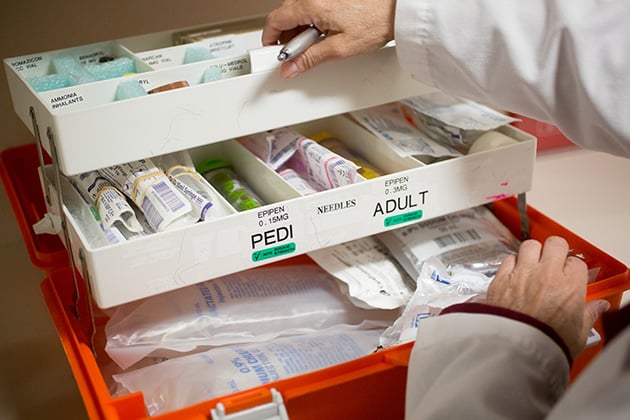
The post So many horrible micro-transactions. appeared first on Indexed.

The post So many horrible micro-transactions. appeared first on Indexed.
This story was co-published with NPR’s Shots blog.
The box of prescription drugs had been forgotten in a back closet of a retail pharmacy for so long that some of the pills predated the 1969 moon landing. Most were 30 to 40 years past their expiration dates — possibly toxic, probably worthless.
But to Lee Cantrell, who helps run the California Poison Control System, the cache was an opportunity to answer an enduring question about the actual shelf life of drugs: Could these drugs from the bell-bottom era still be potent?
Cantrell called Roy Gerona, a University of California, San Francisco, researcher who specializes in analyzing chemicals. Gerona had grown up in the Philippines and had seen people recover from sickness by taking expired drugs with no apparent ill effects.
“This was very cool,” Gerona says. “Who gets the chance of analyzing drugs that have been in storage for more than 30 years?”
The age of the drugs might have been bizarre, but the question the researchers wanted to answer wasn’t. Pharmacies across the country — in major medical centers and in neighborhood strip malls — routinely toss out tons of scarce and potentially valuable prescription drugs when they hit their expiration dates.
Gerona and Cantrell, a pharmacist and toxicologist, knew that the term “expiration date” was a misnomer. The dates on drug labels are simply the point up to which the Food and Drug Administration and pharmaceutical companies guarantee their effectiveness, typically at two or three years. But the dates don’t necessarily mean they’re ineffective immediately after they “expire” — just that there’s no incentive for drugmakers to study whether they could still be usable.
ProPublica has been researching why the U.S. health care system is the most expensive in the world. One answer, broadly, is waste — some of it buried in practices that the medical establishment and the rest of us take for granted. We’ve documented how hospitals often discard pricey new supplies, how nursing homes trash valuable medications after patients pass away or move out, and how drug companies create expensive combinations of cheap drugs. Experts estimate such squandering eats up about $765 billion a year — as much as a quarter of all the country’s health care spending.
Experts say the United States might be squandering a quarter of the money spent on health care. That’s an estimated $765 billion a year. Do you believe you’ve encountered this waste? Tell us.
What if the system is destroying drugs that are technically “expired” but could still be safely used?
In his lab, Gerona ran tests on the decades-old drugs, including some now defunct brands such as the diet pills Obocell (once pitched to doctors with a portly figurine called “Mr. Obocell”) and Bamadex. Overall, the bottles contained 14 different compounds, including antihistamines, pain relievers and stimulants. All the drugs tested were in their original sealed containers.
The findings surprised both researchers: A dozen of the 14 compounds were still as potent as they were when they were manufactured, some at almost 100 percent of their labeled concentrations.
“Lo and behold,” Cantrell says, “The active ingredients are pretty darn stable.”
Cantrell and Gerona knew their findings had big implications. Perhaps no area of health care has provoked as much anger in recent years as prescription drugs. The news media is rife with stories of medications priced out of reach or of shortages of crucial drugs, sometimes because producing them is no longer profitable.
Tossing such drugs when they expire is doubly hard. One pharmacist at Newton-Wellesley Hospital outside Boston says the 240-bed facility is able to return some expired drugs for credit, but had to destroy about $200,000 worth last year. A commentary in the journal Mayo Clinic Proceedings cited similar losses at the nearby Tufts Medical Center. Play that out at hospitals across the country and the tab is significant: about $800 million per year. And that doesn’t include the costs of expired drugs at long-term care pharmacies, retail pharmacies and in consumer medicine cabinets.
After Cantrell and Gerona published their findings in Archives of Internal Medicine in 2012, some readers accused them of being irresponsible and advising patients that it was OK to take expired drugs. Cantrell says they weren’t recommending the use of expired medication, just reviewing the arbitrary way the dates are set.
“Refining our prescription drug dating process could save billions,” he says.
But after a brief burst of attention, the response to their study faded. That raises an even bigger question: If some drugs remain effective well beyond the date on their labels, why hasn’t there been a push to extend their expiration dates?
It turns out that the FDA, the agency that helps set the dates, has long known the shelf life of some drugs can be extended, sometimes by years.
In fact, the federal government has saved a fortune by doing this.
For decades, the federal government has stockpiled massive stashes of medication, antidotes and vaccines in secure locations throughout the country. The drugs are worth tens of billions of dollars and would provide a first line of defense in case of a large-scale emergency.
Maintaining these stockpiles is expensive. The drugs have to be kept secure and at the proper humidity and temperature so they don’t degrade. Luckily, the country has rarely needed to tap into many of the drugs, but this means they often reach their expiration dates. Though the government requires pharmacies to throw away expired drugs, it doesn’t always follow these instructions itself. Instead, for more than 30 years, it has pulled some medicines and tested their quality.
The idea that drugs expire on specified dates goes back at least a half-century, when the FDA began requiring manufacturers to add this information to the label. The time limits allow the agency to ensure medications work safely and effectively for patients. To determine a new drug’s shelf life, its maker zaps it with intense heat and soaks it with moisture to see how it degrades under stress. It also checks how it breaks down over time. The drug company then proposes an expiration date to the FDA, which reviews the data to ensure it supports the date and approves it. Despite the difference in drugs’ makeup, most “expire” after two or three years.

Once a drug is launched, the makers run tests to ensure it continues to be effective up to its labeled expiration date. Since they are not required to check beyond it, most don’t, largely because regulations make it expensive and time-consuming for manufacturers to extend expiration dates, says Yan Wu, an analytical chemist who is part of a focus group at the American Association of Pharmaceutical Scientists that looks at the long-term stability of drugs. Most companies, she says, would rather sell new drugs and develop additional products.
Pharmacists and researchers say there is no economic “win” for drug companies to investigate further. They ring up more sales when medications are tossed as “expired” by hospitals, retail pharmacies and consumers despite retaining their safety and effectiveness.
Industry officials say patient safety is their highest priority. Olivia Shopshear, director of science and regulatory advocacy for the drug industry trade group Pharmaceutical Research and Manufacturers of America, or PhRMA, says expiration dates are chosen “based on the period of time when any given lot will maintain its identity, potency and purity, which translates into safety for the patient.”
That being said, it’s an open secret among medical professionals that many drugs maintain their ability to combat ailments well after their labels say they don’t. One pharmacist says he sometimes takes home expired over-the-counter medicine from his pharmacy so he and his family can use it.
The federal agencies that stockpile drugs — including the military, the Centers for Disease Control and Prevention and the Department of Veterans Affairs — have long realized the savings in revisiting expiration dates.
In 1986, the Air Force, hoping to save on replacement costs, asked the FDA if certain drugs’ expiration dates could be extended. In response, the FDA and Defense Department created the Shelf Life Extension Program.
Each year, drugs from the stockpiles are selected based on their value and pending expiration and analyzed in batches to determine whether their end dates could be safely extended. For several decades, the program has found that the actual shelf life of many drugs is well beyond the original expiration dates.
A 2006 study of 122 drugs tested by the program showed that two-thirds of the expired medications were stable every time a lot was tested. Each of them had their expiration dates extended, on average, by more than four years, according to research published in the Journal of Pharmaceutical Sciences.
Some that failed to hold their potency include the common asthma inhalant albuterol, the topical rash spray diphenhydramine, and a local anesthetic made from lidocaine and epinephrine, the study said. But neither Cantrell nor Dr. Cathleen Clancy, associate medical director of National Capital Poison Center, a nonprofit organization affiliated with the George Washington University Medical Center, had heard of anyone being harmed by any expired drugs. Cantrell says there has been no recorded instance of such harm in medical literature.
Marc Young, a pharmacist who helped run the extension program from 2006 to 2009, says it has had a “ridiculous” return on investment. Each year the federal government saved $600 million to $800 million because it did not have to replace expired medication, he says.
An official with the Department of Defense, which maintains about $13.6 billion worth of drugs in its stockpile, says that in 2016 it cost $3.1 million to run the extension program, but it saved the department from replacing $2.1 billion in expired drugs. To put the magnitude of that return on investment into everyday terms: It’s like spending a dollar to save $677.
“We didn’t have any idea that some of the products would be so damn stable — so robustly stable beyond the shelf life,” says Ajaz Hussain, one of the scientists who formerly helped oversee the extension program.
Hussain is now president of the National Institute for Pharmaceutical Technology and Education, an organization of 17 universities that’s working to reduce the cost of pharmaceutical development. He says the high price of drugs and shortages make it time to reexamine drug expiration dates in the commercial market.
“It’s a shame to throw away good drugs,” Hussain says.

Some medical providers have pushed for a changed approach to drug expiration dates — with no success. In 2000, the American Medical Association, foretelling the current prescription drug crisis, adopted a resolution urging action. The shelf life of many drugs, it wrote, seems to be “considerably longer” than their expiration dates, leading to “unnecessary waste, higher pharmaceutical costs, and possibly reduced access to necessary drugs for some patients.”
Citing the federal government’s extension program, the AMA sent letters to the FDA, the U.S. Pharmacopeial Convention, which sets standards for drugs, and PhRMA asking for a re-examination of expiration dates.
No one remembers the details — just that the effort fell flat.
“Nothing happened, but we tried,” says rheumatologist Roy Altman, now 80, who helped write the AMA report. “I’m glad the subject is being brought up again. I think there’s considerable waste.”
At Newton-Wellesley Hospital, outside Boston, pharmacist David Berkowitz yearns for something to change.
On a recent weekday, Berkowitz sorted through bins and boxes of medication in a back hallway of the hospital’s pharmacy, peering at expiration dates. As the pharmacy’s assistant director, he carefully manages how the facility orders and dispenses drugs to patients. Running a pharmacy is like working in a restaurant because everything is perishable, he says, “but without the free food.”
Federal and state laws prohibit pharmacists from dispensing expired drugs and The Joint Commission, which accredits thousands of health care organizations, requires facilities to remove expired medication from their supply. So at Newton-Wellesley, outdated drugs are shunted to shelves in the back of the pharmacy and marked with a sign that says: “Do Not Dispense.” The piles grow for weeks until they are hauled away by a third-party company that has them destroyed. And then the bins fill again.
“I question the expiration dates on most of these drugs,” Berkowitz says.
One of the plastic boxes is piled with EpiPens — devices that automatically inject epinephrine to treat severe allergic reactions. They run almost $300 each. These are from emergency kits that are rarely used, which means they often expire. Berkowitz counts them, tossing each one with a clatter into a separate container, “… that’s 45, 46, 47 …” He finishes at 50. That’s almost $15,000 in wasted EpiPens alone.

In May, Cantrell and Gerona published a study that examined 40 EpiPens and EpiPen Jrs., a smaller version, that had been expired for between one and 50 months. The devices had been donated by consumers, which meant they could have been stored in conditions that would cause them to break down, like a car’s glove box or a steamy bathroom. The EpiPens also contain liquid medicine, which tends to be less stable than solid medications.
Testing showed 24 of the 40 expired devices contained at least 90 percent of their stated amount of epinephrine, enough to be considered as potent as when they were made. All of them contained at least 80 percent of their labeled concentration of medication. The takeaway? Even EpiPens stored in less than ideal conditions may last longer than their labels say they do, and if there’s no other option, an expired EpiPen may be better than nothing, Cantrell says.
At Newton-Wellesley, Berkowitz keeps a spreadsheet of every outdated drug he throws away. The pharmacy sends what it can back for credit, but it doesn’t come close to replacing what the hospital paid.
Then there’s the added angst of tossing drugs that are in short supply. Berkowitz picks up a box of sodium bicarbonate, which is crucial for heart surgery and to treat certain overdoses. It’s being rationed because there’s so little available. He holds up a purple box of atropine, which gives patients a boost when they have low heart rates. It’s also in short supply. In the federal government’s stockpile, the expiration dates of both drugs have been extended, but they have to be thrown away by Berkowitz and other hospital pharmacists.
The 2006 FDA study of the extension program also said it pushed back the expiration date on lots of mannitol, a diuretic, for an average of five years. Berkowitz has to toss his out. Expired naloxone? The drug reverses narcotic overdoses in an emergency and is currently in wide use in the opioid epidemic. The FDA extended its use-by date for the stockpiled drugs, but Berkowitz has to trash it.
On rare occasions, a pharmaceutical company will extend the expiration dates of its own products because of shortages. That’s what happened in June, when the FDA posted extended expiration dates from Pfizer for batches of its injectable atropine, dextrose, epinephrine and sodium bicarbonate. The agency notice included the lot numbers of the batches being extended and added six months to a year to their expiration dates.

The news sent Berkowitz running to his expired drugs to see if any could be put back into his supply. His team rescued four boxes of the syringes from destruction, including 75 atropine, 15 dextrose, 164 epinephrine and 22 sodium bicarbonate. Total value: $7,500. In a blink, “expired” drugs that were in the trash heap were put back into the pharmacy supply.
Berkowitz says he appreciated Pfizer’s action, but feels it should be standard to make sure drugs that are still effective aren’t thrown away.
“The question is: Should the FDA be doing more stability testing?” Berkowitz says. “Could they come up with a safe and systematic way to cut down on the drugs being wasted in hospitals?”
Four scientists who worked on the FDA extension program told ProPublica something like that could work for drugs stored in hospital pharmacies, where conditions are carefully controlled.
Greg Burel, director of the CDC’s stockpile, says he worries that if drugmakers were forced to extend their expiration dates it could backfire, making it unprofitable to produce certain drugs and thereby reducing access or increasing prices.
The 2015 commentary in Mayo Clinic Proceedings, called “Extending Shelf Life Just Makes Sense,” also suggested that drugmakers could be required to set a preliminary expiration date and then update it after long-term testing. An independent organization could also do testing similar to that done by the FDA extension program, or data from the extension program could be applied to properly stored medications.
ProPublica asked the FDA whether it could expand its extension program, or something like it, to hospital pharmacies, where drugs are stored in stable conditions similar to the national stockpile.
“The Agency does not have a position on the concept you have proposed,” an official wrote back in an email.
Whatever the solution, the drug industry will need to be spurred in order to change, says Hussain, the former FDA scientist. “The FDA will have to take the lead for a solution to emerge,” he says. “We are throwing away products that are certainly stable, and we need to do something about it.”
Help us investigate wasted health care dollars: Experts say the United States might be squandering a quarter of the money spent on health care. That’s an estimated $765 billion a year. Do you believe you’ve encountered this waste? Tell us.
I finished writing my comments to the FCC on net neutrality and Title II classification. In summary, I fully support maintaining the existing Title II classification and using that classification to enforce the existing net neutrality rules. Click through to read my full comments in all their gory detail.
July 8, 2017
Federal Communications Commission
445 Twelfth Street SW
Washington, DC 20554
Re: In the Matter of Restoring Internet Freedom, WC Docket No. 17-108
To whom it may concern:
I am writing to express my strong support for the existing net neutrality protections and for the continued classification of Internet service providers (ISPs) as Title II telecommunications services.
When I pick up the phone and make a phone call, for example to schedule an appointment at my doctor’s office, I expect the phone company to connect me to my doctor’s office. I do not expect them to block the phone call, insert an ad for a different doctor, degrade the quality of my connection to my doctor’s office, or in any other way interfere with my communications with my doctor’s office. I also expect them not to listen in to the phone call, use where I called for marketing purposes, or in any other way attempt to share or use information about where I called or what I said on that call for any purposes.
In much the same way, when I use my doctor’s website to schedule an appointment, I expect my ISP to connect me directly to my doctor’s website. I do not expect them to block the website, insert an ad for a different doctor, reroute me to a different doctor’s website, degrade the quality of my connection to my doctor’s website, or in any other way interfere with my communications with my doctor’s website. I also expect them not to listen in to my browsing session, use which website I visited for marketing purposes, or in any other way share or use information about which websites I visited or what transpired while connected to the website for any purposes.
The similarities between what I use the phone for and what I use my Internet connection for are striking. That’s because where I previously might have picked up the phone and made a phone call, I now do online using the Internet. Much as my phone company used to serve as a common carrier and my Title II telecommunications provider, my ISP now serves as a common carrier and my Title II telecommunications provider. I really expect nothing more from my ISP other than to provide an unfettered and private connection to the websites I want to visit. That’s the very definition of a common carrier and a Title II telecommunications service and thus the appropriate classification of my ISP specifically, and in general, all ISPs.
The chairman has attempted to argue that because most ISPs offer domain name servers (DNS) that somehow transforms them from a telecommunications service into an information service. This argument falls flat. Phone companies offer directory lookup services. Many people never use this optional service provided by the phone companies choosing instead to build their own list of contacts or use a third-party directory service (e.g., look up the phone number of a business on Google). The offering of this optional service never changed their status as providing Title II telecommunications services.
In much the same way, the use of an ISP’s DNS is completely optional. Many people, myself included, do not use the DNS provided by the ISP. They instead opt to use a DNS provided by a third party such as those offered by OpenDNS or Google. Offering an optional information service, which I do not use, in no way changes the fact that I expect my ISP to provide an unfettered and private connection to the websites I want to visit. The underlying expectation of the ISP is still to provide Title II common carrier telecommunications services regardless of what optional information services they may offer on top of that network.
I use the Internet extensively in my day-to-day life. In fact, my modern life would not be possible if I were not able to reach the websites and services I use on a daily basis. I use a lot of the same services others use. I use Godaddy to host my email. I use Google DNS. I use Google Search. I use Facebook and Twitter. I stream video using services like Netflix, Amazon, Vudu, and YouTube. I shop online—often for obscure items I can’t find locally or even in the greater Denver metropolitan area.
I work from home full time using a VPN connection back to my employer. I use instant messaging, Webex, and a VoIP phone to communicate with my coworkers around the world. I use RDP, VNC, and NX to access remote systems at work. I do all my banking on the Internet. I haven’t set foot in a bank in over a decade. I pay my bills online, I deposit checks online, and I check my account balances and transfer funds online. I communicate with my doctor online. I can now check lab results, review follow-up instructions, and refill prescriptions online.
I also use a few cloud-based services and other devices that require a robust upstream connection to remote servers. One such service is a 3D modeling software package where all my design files are stored on a remote system. Another such service is a backup solution that lets me have an offsite copy of all my files, photos, and videos in case of a disaster at home. My thermostat, sprinkler controller, and lighting are accessible over the Internet. I host a small blog using a server a Namecheap.com. I create videos and upload them to YouTube. One of the more advanced applications for the Internet lets me order custom-made circuit boards and another lets me order custom-made 3D printed parts for some hobby-type projects.
If you look at how I use the Internet, not one of the services listed above is a service provided by my ISP. Furthermore, not one piece of information I requested originates within the ISP’s network and not one piece of information I sent terminates within the ISP’s network. If I moved and had to switch to a different ISP, the selection of an ISP would make absolutely no difference in which services I used on the Internet. In fact, my only selection criteria for an ISP would be cost and how well they can connect me to the third-party services I listed above. This further reinforces my point that I expect my ISP to provide an unfettered and private connection to the services I wish to use. The only way to enforce this expectation is through the net neutrality rules and the only way to enforce those rules is to maintain the classification of Internet service providers as Title II telecommunications services.
In the case of a few of the services I use, the ISPs offer their own competing version of the service. For example, I host my blog on a server provided by Namecheap.com because it’s inexpensive and they have good customer service. Comcast has competing hosting services but I don’t use those. In a world without net neutrality protections, Comcast has both the financial incentives and technical means to block, throttle, or otherwise impede their subscribers’ ability to reach Namecheap.com’s servers and thus my blog. This action would force me to pay to use Comcast’s more expensive and less customer-friendly hosting services to reach those subscribers. Then I’d have to repeat this for AT&T, Verizon, and Charter. Quickly hosting my little blog balloons from a reasonable personal expense to something outrageous as the four dominant telecommunications companies abuse their market power in last-mile Internet access to shut down a competing hosting service. Title II classification and net neutrality is essential to prevent this type of abuse.
This type of abuse is most clearly demonstrated in the entertainment realm where a few of the ISPs have imposed data caps and overage charges. By imposing these caps on third-party video services but exempting their own video services, they’re attempting to steer consumers away from competing and often superior video services to their own failing video services. This interference is an abuse of the ISPs dominant position in providing last-mile Internet access. The net neutrality rules don’t specifically ban caps and overage charges but they left open the ability for the FCC to examine their effect on competition on a case-by-case basis. Net neutrality protections and Title II classification are essential to ensuring customers have access to the video services of their choice as well as ensuring the next Netflix or YouTube is not shut down before it’s even started.
As I alluded to above, when I purchase Internet access my primary considerations are the cost of the service, the downstream and upstream speeds of the service, and the ability of the service to connect me reliably to the third-party services I wish to use. If I purchase Internet access at 25Mbps downstream and 5Mbps upstream, I expect to be able to download files from any service or website at 25Mbps and to upload files to those same services or websites at 5Mbps with the only limitation being the ability of the remote server to send or receive data at similar rates. I should not need to purchase a special telecommuters package from the ISP to be able to use Webex or place a VoIP phone call that only runs at 100kbps when I have already purchased 25Mbps/5Mbps Internet service. In fact, the only way for the ISP to create any market segmentation so that they could offer a special telecommuters package would be to interfere with my existing measly 100kbps VoIP stream. Title II classification and net neutrality protect me from this type of abuse.
I live about a mile from the Colorado State University campus in a typical suburban neighborhood. Using the FCC’s definition of broadband, I have one, maybe two, options for broadband Internet access. The first provider is the local cable company. They can provide me with speeds meeting the FCC definition of broadband Internet access. The second option is the local telephone company. The local telephone company just this past month or two began advertising a service using DSL technology that meets the FCC’s definition of broadband. Unfortunately, there’s no real ability to see what speeds I would get without signing up for service due to issues with the local copper loops that vary from household to household. One or two players is not a competitive market by any stretch of the imagination. Similar situations play out across the entire country. Where telecommunication markets are uncompetitive, it is the role of the FCC to ensure the market players do not abuse their market position or abuse their customers.
In conclusion, I strongly support the existing net neutrality protections and the existing classification of Internet service providers (ISPs) as common carrier Title II telecommunications services. I’m fearful the chairman will ignore my comments as well as the millions of other comments in support of a strong and robust Internet ecosystem and instead overturn these most basic of consumer and business protections in the name of securing future profits for a very small set of politically powerful companies.
Sincerely,
/s/ Glen Akins
P.S. I find the title of this docket farcical. Just whose freedom is the chairman attempting to restore? The freedom of consumers and businesses to connect to each other without interference from their telecommunications provider? Or the freedom of their telecommunications provider to interfere with that communication in an attempt to gouge, extract, and milk every last nickel and dime from consumers and businesses? My suspicion is it is the latter.
| archive - contact - sexy exciting merchandise - search - about | |||
 | |||
| ← previous | June 9th, 2017 | next | |
June 9th, 2017: Will I see ANOTHER camel this weekend? The answer is almost certainly no!! – Ryan | |||




Latest short from David Lewandowski continues series of surreal nonsense with warped mocap, this time in Japan:
“Time for sushi“ is the latest in a series of short films inspired by an obsessive passion for nonsense. Preceeded by the films “going to the store” and “late for meeting,” this adventure follows our friend to Japan.
The music is Jean-Jacques Perrey and Gilbert Sigrist’s “Dynamoog”